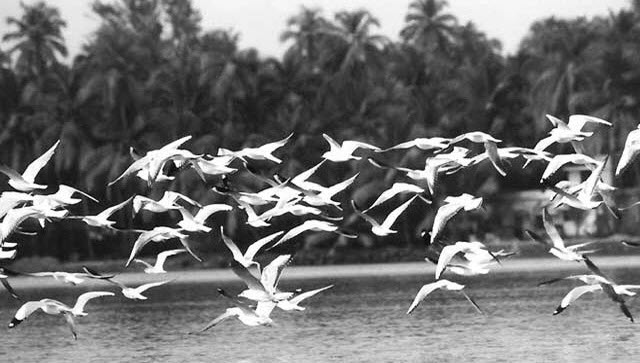The Olango Island Wildlife Sanctuary is located 5 kms east of Mactan Island. The Sanctuary is composed of the main island, Olango, and six nearby islets namely: Sulpa, Gilutongan, Nalusuan, Caohagan, Pangan-an, and Camungi. The total land area of Olango Island Wildlife Sanctuary is approximately 1,030 ha (2,500 acres).
The Olango Island Wildlife Sanctuary falls under the jurisdiction of Lapu-Lapu City and the municipality of Cordova. Former President Corazon Aquino, under Proclamation 903 on 14-May-1992 issued a declaration making the Sanctuary’s 1,020 hectares of mudflats, seagrass beds, and mangrove forests, a protected area.
The total seacoast area of the Wildlife Sanctuary falls under 4 barangays namely: San Vincente, Santa Rosa, Sabang, and Pangan-an, and located in the southern portion of Olango Island. This Wildlife Sanctuary is of international importance because of the waterfowl. The Chinese Egret and Asian Dowitcher are 2 very rare and endangered species of waterfowl that can be found in the Wildlife Sanctuary. Wetland sites are a natural habitation for waterbirds, fish, frogs and invertebrates. Mangrove forests and seagrass beds also abound in wetland sites, and these prevent flooding by sponging the overflow of water. Thus, the Olango Island Wildlife Sanctuary was declared a Ramsar Wetland Site on 1-July-1994.
There are 97 species of birds in Olango Island Wildlife Sanctuary, 48 of which are migratory birds. There are different bird species that could be visually spotted. These are: Chinese Egret, Little Egret, Little Heron, Grey Plover, Kentish Plover, Greater Sand Plover, Far Eastern Curlew, Whimbrel, Bar-tailed Godwit, Common Redshank, Common Greenshank, Common Sandpiper, Terek Sandpiper, Grey-tailed Tattler, Ruddy Turnstone, Asian Dowitcher, Great Knot, Rufous-necked Stint, Curlew Sandpiper, Gull-Billed Tern, Whiskered Tern, Common Kingfisher, White-Collared Kingfisher, Barn Swallor, Pacific Swallor, Yellow-vented Bulbul, Golden Bellied Fly-eater, Pied Fantail, Brown Shrike and Olive-Backed Sunbird.
Approximately 40,000 migratory birds visit the Olango Island Wildlife Sanctuary during the months of November-February, which is considered the peak migration season. The best time to engage in birdwatching is from September-May, at least 2 hours before the high tide.
At the Wildlife Sanctuary, birdwatching, swimming, camping and sightseeing are some of the activities that visitors can engage in. Diving is frequently undertaken, as there are 3 dive sites within the vicinity. These dive sites are Mabini Point, Baring, and Santa Rosa.
The environmental conservation, monitoring, and protection of the Olango Island Wildlife Sanctuary are what keep the Department of Natural Resources (DENR) Secretary Roy Cimatu occupied. The goal of the Philippine government is to strike a harmonious balance between tourist-oriented and government-related activities. What able citizens could do is to be supportive of this endeavor by visiting and promoting the Olango Island Wildlife Sanctuary as a worthy birdwatching and diving destination.
